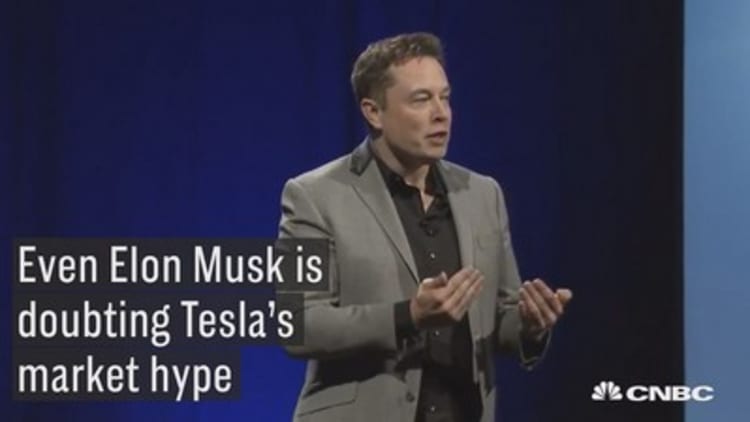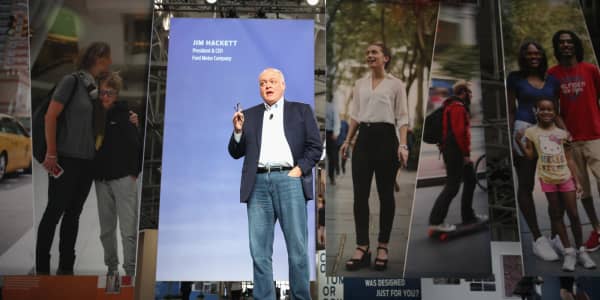
Elon Musk's Tesla is finally delivering the first of its Model 3 cars — the mass-market all-electric vehicle, priced as low as $35,000 before tax credits, that will go a long way toward showing whether Tesla will ever live up to its stock market hype.
Yet Musk and his company remain dogged by skeptics, who point to Tesla's losses, debt load and shaky record of delivering on near-term promises about shipments and manufacturing as reasons to sell the shares short. Even as Tesla's stock has risen more than 50 percent this year, short interest has reached nearly 30 percent of shares that don't belong to insiders, as other investors bet on a big drop. Tesla stock is down 13 percent in the past month.
Even Musk thinks the stock is a little bit crazy, and helped to spark more selling on July 17 with comments that shares are "higher than we deserve right now."
What should Musk do to justify the hype while also meeting the legitimate issues that skeptics identify? We came up with suggestions based on Wall Street research and analysis from market pundits.
1. Hire — and empower — a chief operating officer.
The most persistent criticism of Musk and Tesla has been that it makes promises it doesn't keep, especially about how quickly the company can expand auto production.
One solution: Hire a big-name chief operating officer with a reputation as a manufacturing guru. On a team led by a largely self-taught production expert who also runs a solar-panel company (the former SolarCity, which Tesla acquired last fall) and the rocket firm SpaceX, adding an executive who lives and breathes manufacturing excellence and fills in gaps in Musk's background would be a clear win. And Musk can keep on making pronouncements at offsite conferences about climate change and machine learning that suggest he's really more into vision — which he does better than nearly anyone — than operations.
2. Be more transparent about the things that matter.
Charley Grant, who covers Tesla for The Wall Street Journal's "Heard on the Street" column, rarely tires of pointing out that Tesla hasn't updated the number of Model 3's on back order for more than a year. It's hard to come up with a number that would tell investors more about the company's medium-term future and whether demand for Teslas is softening as competitors roll out electric models, like Chevrolet's Bolt.
On the other hand, the Bolt has sold about 8,000 units so far since its launch in December 2016. The Model 3 backlog is about 400,000. On Monday, Chevy said it was extending a production shutdown at a Bolt plant due to high inventory.
Jim Cramer noted on CNBC that Musk has evaded questions about whether missed guidance on shipments of Model X SUV crossovers and Model S sedans is a sign that demand for the expensive electric vehicles has reached a plateau. And no one really knows how to evaluate Musk's comment last year that the Model Y compact SUV, not even expected to hit the market until 2019 or 2020, will sell as many as 1 million units annually.
The answer is to give Wall Street more information.The best way to shut down guesses and surmises about demand is with real information that will let analysts and investors evaluate the long-term trajectory of Tesla's business.
3. Be less transparent about things that don't matter much.
When Tesla's stock wobbles, as in the drop over the last month, it's often because the company has had a minor miss on a promise about delivery schedules, sometimes driven by short-term manufacturing issues (see "Hire a Chief Operating Officer"). The most recent drop happened when Tesla said it shipped 22,000 vehicles in the second quarter, pushing first-half sales to the low end of its guidance range.
More from iCONIC Tour:
The crucial decision Elon Musk made when he was broke
Meet the $30 million fruit seller keeping Elon Musk's employees happy
Peter Thiel is backing a 22-year-old's dream to clean the oceans
One obvious answer is to stop making short-term promises about details that will come out in the wash once the market knows if Tesla can really sell a million Model 3 units a year, as Musk has predicted. (Global unit sales of all cars and light trucks this year are expected to be about 93.5 million, according to IHS Markit). A few thousand cars, give or take in a given quarter, simply won't matter within a year. Tesla's successes, or failures, will be on a bigger scale. So give the noise machine one less thing to talk about and focus on the things (like demand) that matter in the long run.
4. Decide soon what to do about mobility.
Looming competition from Apple and Alphabet make Tesla bulls' favorite idea — that its electric cars will end up powering a ride-sharing network of self-driving vehicles — less and less certain. Wall Street knows Tesla is interested in the ride-service business, but details of how fast it might happen, and how Tesla might work with partners to bring it to market, remain obscure.
The solution: Decide on a strategy relatively quickly and begin communicating it to Wall Street, including ballpark estimates of what it will cost to go to market and when. Musk's commentary on the subject has been in broad terms. The time to begin explaining how it will work is at hand. If the market decides the plan is workable, Tesla shares should move up toward the $500 best-case targets of bullish analysts like Morgan Stanley's Adam Jonas, who thinks a mobility service would justify the price.
5. Consider separating the mobility and the car business.
Morgan Stanley estimates that Alphabet's Waymo mobility business could be worth $70 billion by 2030 if it takes even 1 percent of the world market for mobility, measured in miles. That's more than Tesla's worth now. CNBC's Jim Cramer has observed that self-driving car services companies, and those that sell technology to them, are likely to command much higher stock multiples than a maturing automaker like Tesla will be able to in the medium term.
It's hard to say precisely what multiple of sales or profit Tesla Mobility might command as a separate business, or as a tracking stock if Musk chooses to manage Tesla's manufacturing and service units as one company for operational reasons. But either a pure information-technology seller or a tech-driven car service would likely command a much higher multiple than an automaker. A software-driven business that supplies multiple automakers (think Amazon Web Services, rather than Apple's closed operating system) should also be able to become profitable faster, with better long-term margins, than any business that depends on bending steel.
Mobility will eventually generate a lot of money, for Tesla or a competitor. And a well-timed spinoff or tracking stock may be the best way to put the biggest share of that money in shareholders' pockets.
6. Turn profitable, Elon.
The biggest argument bears have about Tesla is that it consumes too much money, as investment in its Gigafactory battery plant in Nevada and other expansion projects led to nearly $2 billion in negative free cash flow over the 12 months ending in March. The fear stoked is that at some point the bond market will give up on Tesla, refuse to buy the new bonds, and the shares will go into a tailspin. The company's relatively low bond rating — Standard & Poor's rates its debt B-, which is below investment grade — feeds the argument.
"In our opinion, the direction of Tesla's share price will be dominated by (a) its pace of cash consumption, (b) the excellence and excitement of its products and (c) the openness of capital markets to fund the company's plan," Jonas wrote last week.
The solution is to wean Tesla off of its near-term dependence on the capital markets by turning at least modestly profitable, which Goldman Sachs projects will happen by next year. Tesla has done something like this before, making $574 million of operating cash flow in the middle two quarters of 2016. Whether they can soon do it again depends on how many Model 3's Musk's company can sell. Tesla's $834 million R&D budget was spread over just $7 billion in sales.
That should become a much less painful bite when, or if, the company demonstrates it can manufacture cars rapidly enough to meet pent-up demand, letting Tesla continue to invest in mobility while still showing the markets that a long-running payoff on its Tesla investment is just around the corner. But it could mean Musk has to go slower on other expansions, something he might not be willing to do.
— By Tim Mullaney, special to CNBC.com





